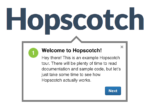I’m just about to launch a brand new project to the world. As a small business, part of the work I’m doing on the project is looking at how I can use smart technology solutions to engage with new users automatically, and help them through the process of getting up and running.
If you’ve used modern software-as-a-service products – you’ll be familiar with these sorts of solutions, that can include things like:
- Online knowledgebase articles
- Drip-fed email series
- Online product tours
I’ll probably talk about some others another day, but today I’m looking at “Online product tours”. This is where you have pop-up dialogs guide the user through key features of your app. Not sure what I mean, check out the final result, the welcome tour on MyHill.blog.
I looked at a couple of Javascript based open source packages when I was building the tour:
As you might have guessed from the article title, I finally settled on Hopscotch for my tours. For me, the advantages where the ease with which I could get multi-page tours set up, support for callbacks, and of course the actual user-facing experience.
Shepherd was my first favourite, and I got most of the tour implemented in this initially. However I hit a couple of issues running some code I needed on callbacks – I couldn’t easily get them to run at the right time. The transitions between steps were also a little harsh for my liking, it was easy to get confused jumping between sections of (potentially) long pages. Other than that though it was a solid, good-looking solution.
I really liked the highlighting offered by intro.js, but it didn’t quite work for everything I wanted to do, and the out-of-the-box theming was a little simple for my liking. Other than that though it also seemed fairly nice.
Overall, I think I’d be happy working with any of these three in the future, but Hopscotch was definitely the best match for this project.
